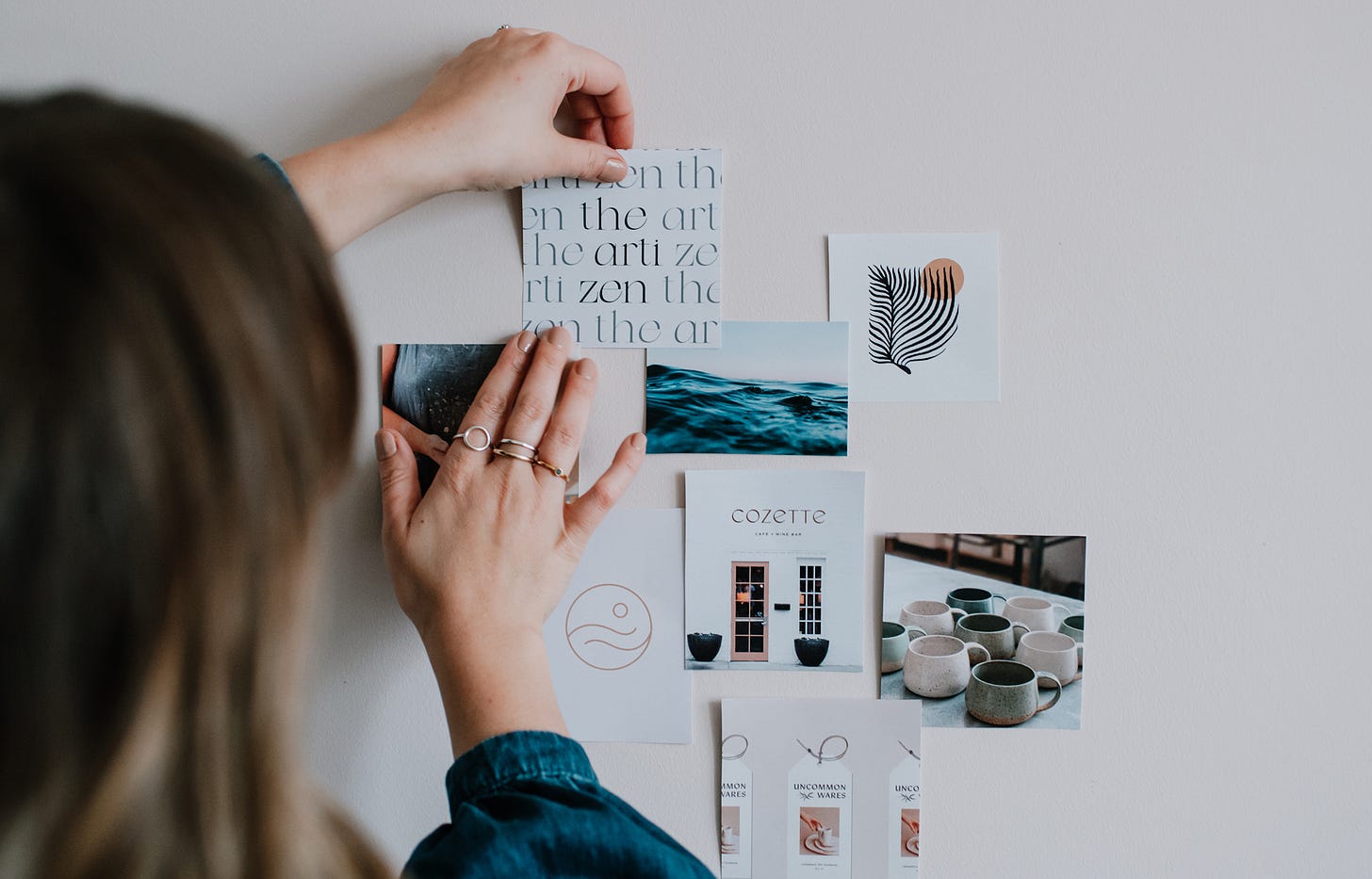Building a brand from the ground up
Making sense of branding is helpful for anyone aspiring to establish a meaningful and memorable online and offline presence.
Hi friends,
Today I’m very excited to bring you a guest post from
. I love how Sarah thinks about branding and I’m very glad to have her share her thoughts about building a brand with us today. If you want to learn more about Sarah’s work, I recommend this post.If you want to learn more about how we think about branding, specifically on Substack, you can read this post from our archive that goes into depth on setting up your publication so it is aesthetically and narratively compelling.
Making sense of branding is helpful for anyone aspiring to establish a meaningful and memorable online and offline presence. Because at the heart of almost every thriving business, product, or service—even the notion of personal branding—lies an intentional strategy, style, and story.
When asked to describe branding in simple terms, I first explain the need to distinguish branding from visuals. While design is part of the picture, branding is so much broader. I liken it to building a home; strategy forms the groundwork and pillars, style dictates the layout and design, and story adds texture and feeling. This layered approach can help you identify gaps within your overall brand build and spot opportunities for improvement. Does the infrastructure need attention? Could you make the space more attractive? Is the tone right for the environment?
Some find the idea of branding intimidating, but, really, it's just a helpful guide, moving us toward effective problem-solving and decision-making, streamlined communication and meaningful relationships. Branding doesn't have to be on a big and bold scale to be effective; often, it's in the micro-moments of connection where we see the most natural expression of a business, product, or service. And it’s there that the audience or consumer experiences a brand.
Strategy: laying the groundwork & raising the pillars
When building a brand, having a clear plan is helpful, and I begin by looking at three core elements: foundations, positioning, and essence. Combined, they form a blueprint and can help you feel assured, gain clarity, and be decisive.
Foundations: This is about establishing the basics of your brand strategy with a focus on vision, purpose, and beliefs. It's your bedrock, supporting the continuous evolution of your brand. Defining your 'why' and aligning your plans with your long-term aspirations and what matters to you will set the tone for your brand build.
Positioning: Knowing your audience, market, and difference is crucial in distinguishing your business, product, or service from others. Your audience comprises 'who' your brand caters to and those who engage with you. The market is the sector or industry or space you occupy. And your difference sets you apart.
Essence: At its core, brand essence is about distilling the very heart of your brand—capturing its unique nature while upholding nature, integrity, and harmony. The blend of these elements guides how you show your brand to the world and how it's perceived. By considering these facets, your brand essence drives everything your brand does.
Together, these strategic components will hold up your brand. By thoughtfully considering each aspect, you can more effectively create something that supports you and resounds with your audience.
Styling: mapping the layout & crafting the design
Once we've established a strategy, we can transition to styling—the visual incarnation of a brand. The creative process involves capturing distinctive features to create an identity that speaks up and stands out and involves several elements. At its crux, styling is about translating a strategy into something more tangible.
Note: before sharing the details of design, I want to briefly touch on moodboard creation. I always begin creative projects with a collage of images, textures, typography, and colours that may visually represent a brand. This can inspire those involved in a project and assist with defining a coherent style.
Logo: A brand can be represented by a symbol or icon, though sometimes it is typographic (based on fonts). A logo will ideally be simple, memorable, and adaptable. To facilitate this, primary and secondary versions will often be created. These will usually be versatile enough to be applied across different platforms and mediums, from socials and websites to stationery and packaging.
Palette: Colour offers a powerful way to communicate, evoke associations and emotions, and inspire. Brands such as Barbie, Louboutin, and Tiffany have colour trademarks, an approach I'm not suggesting you follow! But it highlights the power of a palette because, carefully chosen, it can reflect the nature of your brand or even become more recognisable than a logo or other visuals.
Typography: More than choosing fonts, typography is about crafting a visual voice. The style and weight of a typeface—and the space within and around it—contribute significantly to how a brand communicates its message. Whether classic, detailed, or modern, the approach to typography will ideally align with a brand’s overall personality and form an integral part of all communication.
Beyond colour and typography, design elements like stamps, graphics, and photos can help to develop a cohesive visual identity. These often complement one another, harmoniously working to support the brand’s strategy and story.
Storytelling: creating texture & evoking feeling
Storytelling covers how a brand communicates 'what' it stands for and 'why' it exists. This layer is vital because it’s about character and expression, and often dictates how your brand is perceived. However, I like to take account of the whole customer, reader, or visitor journey. Because when thought is given to the bigger picture and messages are crafted with care, it builds greater connection. Here are three key considerations:
Function: Storytelling colours all communication—from digital content to direct contact. It’s not fluff; it’s function. A well-crafted narrative uplifts, inspires, and enlightens, fostering a sense of connection in a way that design alone cannot. It can take time but is a vital component, adding strength and stability, which makes tending to your messaging worthwhile.
Authenticity: Maintaining a consistent and genuine narrative across all platforms bolsters credibility. I liken it to moving from room to room within your home. If the feeling is wildly different on your socials and your website, it will subconsciously jar with your reader or viewer, so it can help to ensure your messaging is clear and constant across various touch points.
Meaning: This aspect looks beyond the function of storytelling and the need for genuineness to connect through emotion, highlighting value, and showing how your approach, products, or services can make a positive difference. By speaking to your audience and their desires, by sharing your journey, challenges, and triumphs, you will also appeal to their humanness.
A clear strategy, style, and story can give you strength in your offering, pride in your appearance, and trust in your narrative. And collectively shape the experiences and perceptions of clients, customers, and collaborators.
Curious to explore further? You might like to reflect on how you feel about your brand:
Strategy: Are you clear on foundations, positioning, and essence? Are there areas where you could strengthen your approach?
Styling: How do you feel about your current logo, palette, and typography? Do they reflect you and your brand? What changes, if any, could enhance them?
Storytelling: How does your brand narrative connect with your audience? Are there aspects of your message that you could improve?
Do these elements work harmoniously, or are some stronger than others? Where do you see possibilities for greater alignment?
Share your thoughts, or join me at
for more insights.If you like this one, I highly recommend you check out this one from Sarah’s archive.
is a brand designer, creative mentor and writer. Collaborating with clients to define their vision, craft beautiful visuals and discover their voice is at the heart of her studio, These Are The Days.Join Sarah at
, a Substack dedicated to curiosity and creativity, where she's creating a podcast, playdeck and paper to support her readers with their independent businesses and creative practices through strategy, styling and storytelling.If you like this one, consider becoming a paid member to support articles like these. It takes a long time to curate the best author growth articles and bring them to you. Additionally, you get access to over a dozen comics, novels, and nonfiction books behind our paywall. If you are not a paid member, you can read everything with a 7-day free trial, or give us a one-time tip.











Thank you Sarah particularly for sharing the audit questions towards the end of this article: I think I will work through these next week 🤩
This post was so insightful and helpful, thank you! Saved to revisit :)